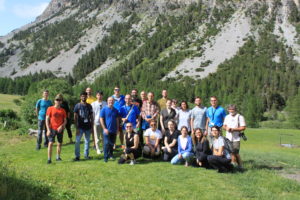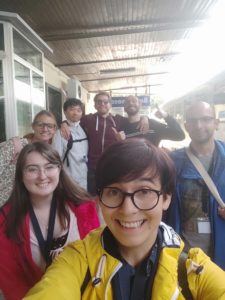MINEWA is an international EMU-SIMP (European Mineralogical Union – Società Italiana di Mineralogia e Petrologia) school on mineral constituents of wastes, their characterisation, recovery and management. This school brought students and experts worldwide to discuss; the edge of waste management, background information on what wastes are and how they are managed, the basics of the high and low temperature geochemistry involved, and a sense of all that is going on in the different fields of waste investigation and how they are linked in minerals. This has benefitted my PhD project by enhancing my knowledge of anthropogenic waste and developing my confidence to present this knowledge to students and experts worldwide. It has also helped me develop networking and potential collaboration projects with the people I have worked with at this school.
This is a very long post detailing each day I was out there so here are the highlights;
- An all round great experience, meeting new people and different research projects. A great networking opportunity.
- Treasure hunts, hiking, ping pong tournament, interesting italian delicacies…(cows stomach!) and more…..

Day 1
We arrived in Bardonecchia at noon to start the school with our first talk by Mario Tribaudino (the event organiser). Mario’s talk introduced the problems with waste and how research can help us deal with it. The talk discussed some examples of minerals in waste and environmental media. Mario compared the mineral processes occurring in the bottom and fly ashes from incinerator plants and their natural counterparts. They showed similarities and differences in their chemical, structural and mineralogical features and how we can interpret them.
Maria Chiara Zanetti and Deborah Panepinto did the second talk on “What is waste, and how we manage it”. Here examples of reusing and recycling wastes and an environmental assessment of performed operations were presented. The chemical and physical processes were discussed and their energy requirements.
The evening event was to be a causal stroll into Bardonecchia; however, this ended up being a walk up the nearest mountain! (I think I got lost in translation…)
Day 2
The second day started with a talk on thermodynamics and kinetics of HT processes by Alessandro Pavese. This talk brought attention to how far classical thermodynamic tools lie regarding natural systems’ energetic behaviour and guidelines about the complementary strategies to model and interpret a complex process such as municipal solid waste incineration.
To end the morning session, Patrizia Onnis (Post doc from CSM) and I talked about the low-temperature geochemistry of waste. The talk was based on the chapter my supervisor (Karen Hudson-Edwards) had written for the school. Patrizia, my other supervisor, Rich Crane, and I also contributed to this book. We discussed the different types of anthropogenic waste you could get with their geochemistry and mineralogical variations. I also had the opportunity to talk about my own research and share what I have been doing and how it related to the school. At the end of the presentation, we gave the participants a treasure hunt quiz. For each answer, you had to take the first letter, which made an anagram. The winner was the first to solve the anagram and would win some Cornish chocolate. Davide (PhD student) from Turin University was the first to solve the puzzle, with the answer being Malachite.
To open our afternoon session, Joris Dijkstra discussed the geological significance of novel anthropogenic materials (NAM) (deposits of industrial waste and by-products). The beginning of the talk first discussed how the Netherlands had used these ‘NAM’ and how widespread they had become. The talk then led to a discussion on the geochemical properties of three types of ‘NAM’ heavily used in construction; Ash, Steel and Stony aggregate. The discussion included a comparison of natural materials along with their interaction and impact on the environment
The final talk was given by Giovanni De Giudici, who spoke about Bio-mineral interactions and the environment. This talk showed the biominerals ability to decrease bioavailable metals and pollutants. Along with highlighting the importance of biomineralisation in mineral stability and evolution; and how biominerals offer new tools for mine operations sustainability that can also be used in other industrial technology.
The evening activity consisted of preparing for our ping pong contest that Patrizia had organised for Day 4.
Day 3
The morning session opened with Emma Campbell, whose talk was slightly different from the others. The talk used the example of a supermarket and it’s ability to make a food circular economy. This example showed how, a population could circulate food consumption and how effective it could be. It made us think about the sources of our food and how we could reduce the CO2 consumption it took to arrive in the markets, along with our relationship with food in the UK being heavily processed and quick, with no thought into the meal itself; i.e. Where did it come from? How did it get here? This could then be applied to a larger scale, such as the ceramics or mining industry.
The last talk of the morning was from Raffaele Vinai, another University of Exeter representative. They gave an overview of bottom and fly ashes and how we can utilise them, and how their ability to uptake heavy metal(loids) and organic pollutants could be used for extracting valuable resources, along with developing techniques for their inertization of harmful materials.
In the afternoon, we went for a very wet (much like Cornwall!) hike up to Valle Stretta crossing the Italian border into France to have a hot chocolate and a piece of cake.

Day 4
This was a much more intense day with 6 talks as day 5 would only be a half-day.
Gilberto Artioli started the day with their talk on the past and present use of metal resources and the main metallurgical processes. The discussion explicitly focused on the wastes produced during the metallurgical cycle of iron/steel and the environmental consequences following the exploitation of sulphide ore bodies.
This was followed by Daniel Vollprecht, who gave an overview of slags and their recyclability. They also discussed the limitations of its recyclability and treatments for their leachable contaminants.
To end the morning session, Maurizio Bellotto did a talk on construction and demolition waste. They described the waste types and their recovery and discussed the benefits and drawbacks of using recycled aggregate as a replacement for primary materials. However, this new method of screening and surveying properties before demolition has an economic barrier due to the production cost being much higher than using primary materials. Another critical point they touched on was creating buildings that would last forever (flexible floor plans with non-structural partitions) so that the demand for these resources and thus the waste would be much lower.
During the lunch break, I discovered other research projects during the poster session. This allowed me to meet new people, discuss their research, and help develop my research.
To open the afternoon session, Chiara Zanelli discussed the feasibility of a circular economy in the silicate ceramic industry. They brought to light the problem of increasing demand on resources and the possibility of utilising; waste glasses, slags, construction and demolition wastes in different silicate ceramics to overcome this demand.
The second talk was by Giovanna Dino, who discussed the issues and the possibilities of mining-derived tailings. They also mentioned a project they had worked on in Italy to identify critical raw materials in these legacy tailings. This project had a few parallels with our Legacy Wastes project, and so we have made a connection for potential future works together.
The evening session consisted of the ping pong tournament mentioned earlier. We were randomly coupled and the competition lasted 2 hours, with the winning prize being a postcard from Cornwall. The winners were Maurizio and Andrea, two professors at the school.
Day 5
Francesco Turci started the first talk by discussing the health and environmental impacts of waste and its treatment. They highlighted that health and environmental risks from waste and treatment depend on socioeconomic factors. The talk concluded with the need for correction in global hazardous waste management that is urgently required to limit the risk of improper handling and disposal of wastes.
Astrid Allesch did the last talk of the school, which followed on from Francesco’s. They discussed ‘a global strategy for waste management. This looked into the sustainable development goals of waste management, the worldwide progress in reaching this goal, and the circular economy action plan for the European green deal. They also highlighted the trends and challenges for waste management. They summarised that not only do we need a technical solution for the waste and resource problem, but we also need to change consumers’ behaviour and transform industrial production and the economic system.
We ended school with a few of us going out for dinner. I accidentally ordered cow’s stomach! (not intentional – lost in translation…again) and can, hand on heart, say I am not a fan! However, this didn’t ruin my experience of the whole school.
This school not only provided me with increased experience and networking contacts, it also developed my confidence and allowed me to make new friends from around the world.
